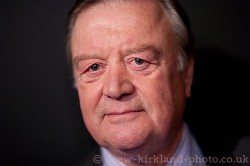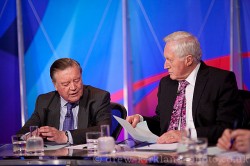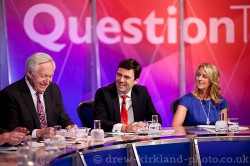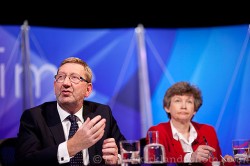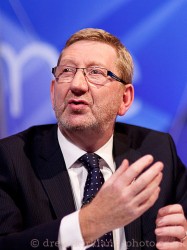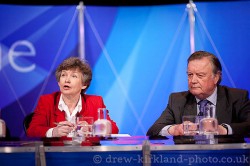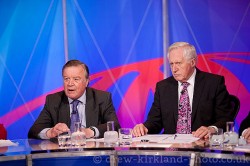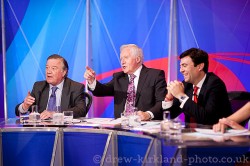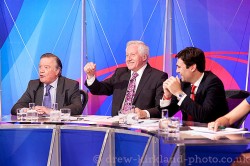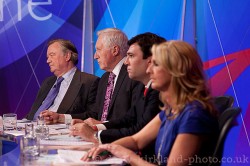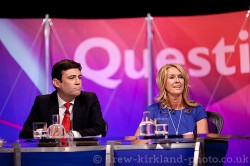BBC’s Question Time is one of the UK’s most popular current affairs broadcasts. It’s mixes a fairly balanced panel of 5 or 6 politicians, businesspeople or journalists and puts them in front of an audience, who can ask questions for an hour. It’s hosted by David Dimbleby. Questions are meant to be topical and “provocative”.
Although it’s a “roadshow”, visiting different locations, there’s a consistent set and format.
This week, the show was hosted by my College, and I was given a chance to get some shots for the College’s Marketing Dept. I was in “the pit”, and there was another student with a longer lens on the gantry.
You don’t get many of these opportunities, so I wanted to get it right.
I was also aware that I didn’t want to compromise the College’s relationship with the production company – or they won’t want to return.
So it’s really important not to get in the way.
Camera / Lens Selection
I wasn’t sure of the lighting levels I’d be able to get. I’ve an old Canon 5D, so I wanted to keep the ISO down to around 200. So I arranged to get hold of a fast prime – in the end, I used a Sigma 85mm f1.4 – probably the best compromise between speed and focal length.
In the event, I found that – at f/1.4 wide open – I could get about 1/200 sec. Stopping down to f/3.2 slowed things down to 1/40 sec – a bit more liable to shake, and probably not fast enough to “freeze” a panel member as they’re speaking.
I also had a 24-70 f/2.8 zoom in my bag – in the event, I didn’t get a chance to use it.
If I got another opportunity, I’d maybe try a 70-200mm f/2.8, and turn up the ISO by another stop – or a cropped-sensor camera (although that loses a bit of light) but I’m being picky – the 85mm was super.
Format
The show is recorded live, and broadcast about an hour after the end – so the actual recording was between 8:30pm – 9:30pm, and the broadcast started at 10:30pm.
We got access at 7:45, during the warm-up, when a panel from the audience – with the floor manager as “host” – ran through some dummy questions.
Apart from the technical setup – mics, cameras, lights positioning etc., this gives the production staff a chance to find out about some of the characters in the audience. It also gets the audience relaxed and used to talking.
The Floor Manager is your main contact. He’ll tell you what to do, and when to get out. Obey him.
About 8:15, the live panel are introduced. Dimbleby is very much in control. He’s completely self-assured and exudes an air of calm confidence. He’s been doing this for a long time.
This particular week, the panel included (left to right) Len McCluskey (of my old union, Unite), Ruth Lea (economist), Kenneth Clarke (Justice Minister), Andy Burnham (Shadow Health Secretary) and Julie White (Midlands Businesswoman of the Year, and MD of D-Drill). And, of course, it’s chaired by David Dimbleby.
“You’ve got one Question”
I’m only allowed to take photos of the panel. No audience photos – although they’ll be on the telly !
Then I’m allowed in. I’ve can only shoot during the first “question” – that one isn’t recorded. So a total of 10 mins. A lot of that isn’t the panel talking, it’s audience members, while the panel are getting themselves comfortable, rather than making interesting shots …
So you need to get into position as soon as you know which of the panel is going to be speaking. I took a variety of photos of the panel and their neighbours.
The set layout meant that I couldn’t get all of the panel into one shot.
Even with a wide-angle lens, fitting everyone in would have been tricky – the set has a semicircular layout, which works really well for TV long shots, and lets the closeup cameras isolate the subjects.
Not ideal for a stills ‘tog on the ground, though.
Other constraints
The floor manager told me to stay out of the camera lines – even though it wasn’t recording. This isn’t too bad – the cameras are at either side, so you can stay in the middle of the set.
The big “Q” at the front of the set meant I couldn’t get as close as I’d have liked (although – to be fair – the cameramen might have got upset if I had!). So a slightly longer lens might have helped.
After the first question the floor manager asked me to bail – I was already on my way. In total, I had 12 minutes (elapsed) shooting time. Here’s an edit of the shoot …
